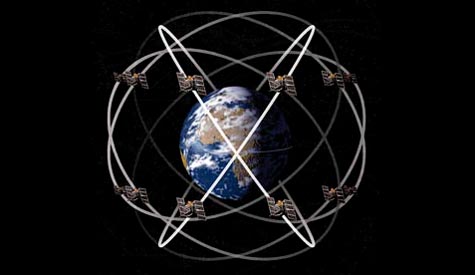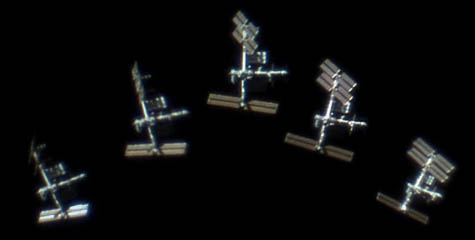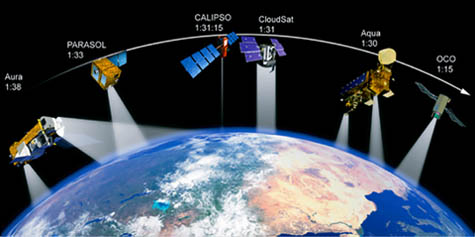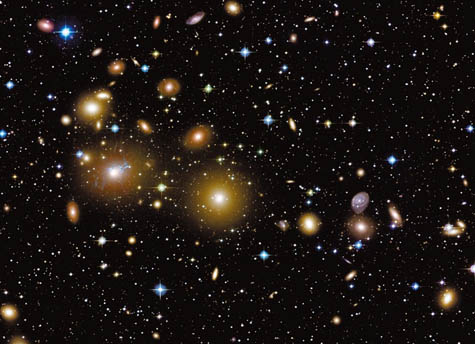You can point up at the sky for amazed friends, saying watch this – and a light appears, way up above you, beyond even where airplanes fly.
 What's passing overhead in this instance is something called the Iridium constellation, an artificial pattern made of 66 telecom satellites (there were supposed to be 77, which would have corresponded with the number of electrons in an atom of iridium).
What's passing overhead in this instance is something called the Iridium constellation, an artificial pattern made of 66 telecom satellites (there were supposed to be 77, which would have corresponded with the number of electrons in an atom of iridium). The whole thing was sold less than a decade ago for a mere $25 million to private investors – after being launched and constructed, in the 1980s, at a price of nearly $6 billion.
 The company that initially sponsored the project went bankrupt in 1999 – raising the prospect, like something from Greek mythology as rewritten by Philip K. Dick, or perhaps something out of Arthur C. Clarke as rewritten by Homer, that our sky will someday be full of artificial constellations, their human creators having long since disappeared. Cold, dead objects, they'll encircle the world in silence.
The company that initially sponsored the project went bankrupt in 1999 – raising the prospect, like something from Greek mythology as rewritten by Philip K. Dick, or perhaps something out of Arthur C. Clarke as rewritten by Homer, that our sky will someday be full of artificial constellations, their human creators having long since disappeared. Cold, dead objects, they'll encircle the world in silence.  Along these lines, a new exhibition of photographs by geographer Trevor Paglen opens here in the Bay Area next week, called The Other Night Sky. The Other Night Sky "looks to the night sky as a place of covert activity," we read:
Along these lines, a new exhibition of photographs by geographer Trevor Paglen opens here in the Bay Area next week, called The Other Night Sky. The Other Night Sky "looks to the night sky as a place of covert activity," we read:[W]orking with data compiled by amateur astronomers and hobbyist “satellite observers,” cross-referenced across many sources of information, [Paglen] tracks and presents what he calls “the other night sky.” Large-scale astro-photographs isolate barely perceptible traces of surveillance vessels amidst familiar star fields, and a digitally animated projection installation covers the globe with 189 currently orbiting satellites.In other words, Paglen has been tracking surveillance satellites – false stars that would otherwise have blended in with astronomy.
It genuinely amazes me to think that, 45,000 years ago, groups of cognitively modern humans were wandering around Australia and the Middle East and Africa and South Asia, and they were looking up at and navigating themselves by recognizable patterns in the sky – but, now, we can just install our own stars there and guide ourselves by them, instead.
 [Image: The International Space Station, from a series of photos by Dirk Ewers].
[Image: The International Space Station, from a series of photos by Dirk Ewers].We are now partially building ourselves a new night sky – yet this surrogate astronomy is being put there simply so we can spy each other and make international phone calls.
 In some ways, I'm reminded of a line from Richard Kenney's 1993 book of poetry The Invention of the Zero. At one point, Kenney writes: "Imagine, all new constellations!" as if it is some impossible, heroic act of celestial reinvention yet to occur in human history.
In some ways, I'm reminded of a line from Richard Kenney's 1993 book of poetry The Invention of the Zero. At one point, Kenney writes: "Imagine, all new constellations!" as if it is some impossible, heroic act of celestial reinvention yet to occur in human history.But the weird irony of life is that we've already done that – and we didn't overthrow the astronomers, or plan a coup in the planetarium of human thought, we just launched some telecom satellites and bought a bunch of mobile phones, and now we have it: we have new constellations – what Kenney calls "unfamiliar skies" – flashing through the night at timed intervals.
 In any case, I've been tracking these constellations on a little Applet today – but there's a certain sinister side to all of this, too. Space warfare, we read, is the militarization of the earth's high atmosphere, weaponizing low-orbit space. You can thus strike anyplace on the earth within mere minutes of ordering an attack – including the infamous "rods from god," which are non-explosive tungsten rods dropped from extremely high altitude:
In any case, I've been tracking these constellations on a little Applet today – but there's a certain sinister side to all of this, too. Space warfare, we read, is the militarization of the earth's high atmosphere, weaponizing low-orbit space. You can thus strike anyplace on the earth within mere minutes of ordering an attack – including the infamous "rods from god," which are non-explosive tungsten rods dropped from extremely high altitude: These rods, which could be dropped on a target with as little as 15 minutes notice, would enter the Earth's atmosphere at a speed of 36,000 feet per second – about as fast as a meteor. Upon impact, the rod would be capable of producing all the effects of an earth-penetrating nuclear weapon, without any of the radioactive fallout. This type of weapon relies on kinetic energy, rather than high-explosives, to generate destructive force.All these coordinated astronomical stand-ins – patterned groups of satellites moving around the world – thus might also someday serve as malign horoscopes of impending war. To what zodiac would such military constellations correspond? What defensive measures might a person take when a strange metallic glint appears in the evening sky, a 20-second flash on the horizon?
 [Image: The Perseus Cluster, photographed by Jean-Charles Cuillandre & Giovanni Anselmi].
[Image: The Perseus Cluster, photographed by Jean-Charles Cuillandre & Giovanni Anselmi].And what would we do if we found out that Orion, say, or the Southern Cross, was not a natural constellation at all, but something placed there, installed above us, in our imaginations, in our myths?
(Trevor Paglen's The Other Night Sky, from which this post's title was taken, opens June 1st at the Berkeley Art Museum).
No comments:
Post a Comment